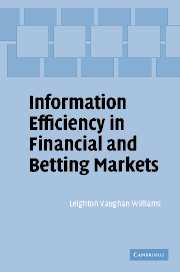Book contents
- Frontmatter
- Contents
- List of figures
- List of tables
- List of contributors
- Introduction
- Part I The concept of information efficiency
- Part II Selected readings
- 4 An assessment of quasi-arbitrage opportunities in two fixed-odds horse-race betting markets
- 5 The presence of favourites and biases in bookmakers' odds
- 6 Searching for semi-strong form inefficiency in the UK racetrack betting market
- 7 Models, markets, polls and pundits: a case study of information efficiency
- 8 Longshot bias: insights from the betting market on men's professional tennis
- 9 Biases and insider trading in exotic bets on thoroughbreds
- 10 On the improbability of information efficient parimutuel betting markets in the presence of heterogeneous beliefs
- 11 Modelling gambling demand in a laboratory casino: discovering the importance of individual-specific effects
- 12 Market efficiency of the 50–30–20–10 horse-racing spread betting market
- 13 Insider trading and bias in a market for state-contingent claims
- 14 Rationality and efficiency in lotto games
- 15 Efficiency of the odds on English professional football matches
- 16 Modelling distance preference in flat racing via average velocity
- 17 Testing for market efficiency in gambling markets: some observations and new statistical tests based on a bootstrap method
- 18 Information (in)efficiency in prediction markets
- Index
- References
13 - Insider trading and bias in a market for state-contingent claims
Published online by Cambridge University Press: 09 July 2009
- Frontmatter
- Contents
- List of figures
- List of tables
- List of contributors
- Introduction
- Part I The concept of information efficiency
- Part II Selected readings
- 4 An assessment of quasi-arbitrage opportunities in two fixed-odds horse-race betting markets
- 5 The presence of favourites and biases in bookmakers' odds
- 6 Searching for semi-strong form inefficiency in the UK racetrack betting market
- 7 Models, markets, polls and pundits: a case study of information efficiency
- 8 Longshot bias: insights from the betting market on men's professional tennis
- 9 Biases and insider trading in exotic bets on thoroughbreds
- 10 On the improbability of information efficient parimutuel betting markets in the presence of heterogeneous beliefs
- 11 Modelling gambling demand in a laboratory casino: discovering the importance of individual-specific effects
- 12 Market efficiency of the 50–30–20–10 horse-racing spread betting market
- 13 Insider trading and bias in a market for state-contingent claims
- 14 Rationality and efficiency in lotto games
- 15 Efficiency of the odds on English professional football matches
- 16 Modelling distance preference in flat racing via average velocity
- 17 Testing for market efficiency in gambling markets: some observations and new statistical tests based on a bootstrap method
- 18 Information (in)efficiency in prediction markets
- Index
- References
Summary
Introduction
This chapter aims to shed light on the functioning of a market for state-contingent claims with inside traders. Many markets are beset by clandestine and illegal insider activity, which much effort has been made to control. The Melbourne horse betting bookmakers' market considered in this chapter is unusual in that insider trading is legal there. In many markets for state-contingent claims, including most betting markets, a favourite-longshot bias is observed throughout, but decreases over time. In the context of a horse betting market, a favourite-longshot bias implies that favourites are underpriced relative to longshots. The explanations given in the literature for this common phenomenon, which is seemingly incongruent with market efficiency, are briefly summarised below for the case of bookmaking markets. Although the typical market for horse bets lasts 30 minutes at most, it goes through several phases with more than one set of prices, as explained below. The analysis presented in this chapter suggests new explanations for this phenomenon.
In contrast to (legal) US horse betting markets, which are only parimutuel, betting on-course in Australia takes place with both a parimutuel and bookmakers. In parimutuel betting, the bettors on horses do not know the return odds until all betting is completed and the total revenue, minus tax and costs, is divided among the winners, proportionally to the bets made. Bookmakers, on the other hand, offer bets at fixed odds, which are more amenable to profitable exploitation by shrewd insiders.
- Type
- Chapter
- Information
- Information Efficiency in Financial and Betting Markets , pp. 287 - 312Publisher: Cambridge University PressPrint publication year: 2005
References
- 3
- Cited by



